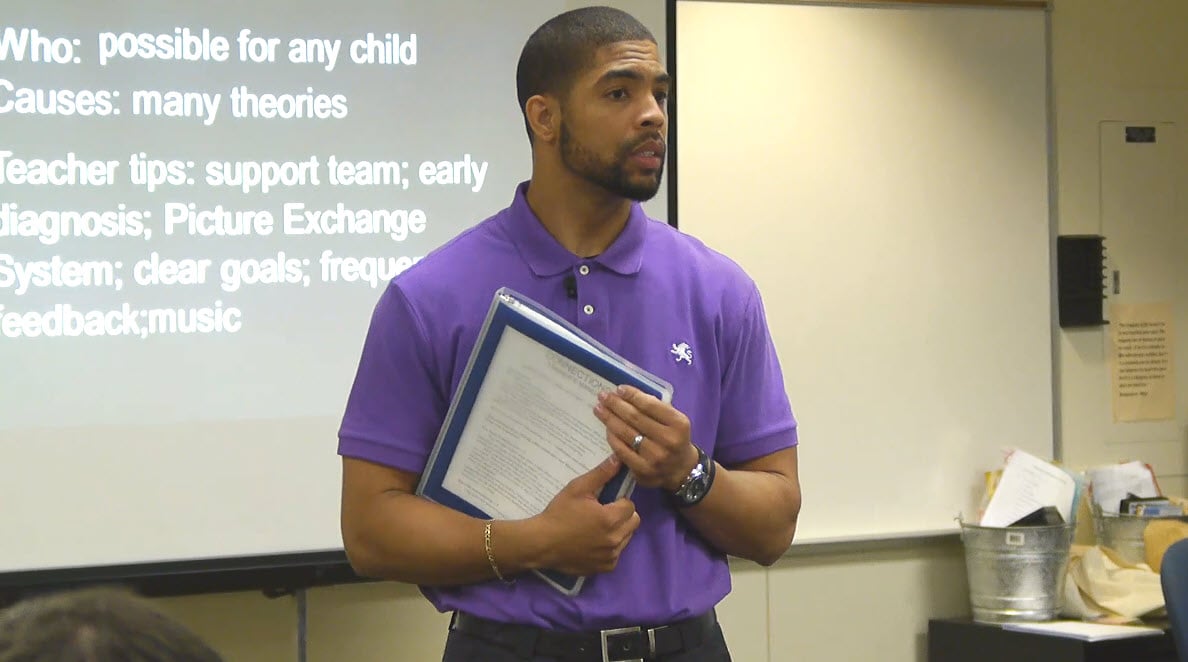



Nearly 1 in 10 Texas students receive specialized services from special education teachers within their school district.
The primary role of a special education teacher is to work with students who have learning, mental, emotional or physical disabilities. Special education teachers adapt general education lessons and teach various subjects to students with mild to moderate disabilities, but also may teach basic skills to students with disabilities that are more severe.
While some special education teachers have their own classrooms, others may work side-by-side with general education teachers to help special education students thrive in the general classroom setting.
While the above describes the general role of a special education teacher, this type of educator oversees and performs many more activities on a daily basis, which we’ll explore below.
To understand the role that a special education teacher plays in the classroom, it’s important to first know what a special education teacher is and who this specialized type of educator serves.
education teacher is and who this specialized type of educator serves.
What is a special education teacher? A special education teacher works with students who have a variety of disabilities. Special education classroom teachers typically work with and instruct kids in grades preschool through 12th who have mental, learning, emotional or physical challenges.
Who special education teachers serve varies, but overall, a special education teacher works with children who have a variety of individual differences that make it more difficult for them to learn unassisted in a general classroom.
While every child is unique, the Individuals with Disabilities Education Act breaks disabilities into 13 categories:
In Texas, the number of students in special education classes has grown nearly 38% since 2013, according to the Texas Education Agency. Special education students make up roughly 11% of the pre-to-12th grade student population in the state.
Special education teachers provide students with the level of support they need with the goal of keeping these students included in general education classroom activities as much as possible. In fact, in Texas, an estimated 65% of students who are in a special education program spend 80% of their day in a general ed classroom.
Depending on the needs of the students, a special education teacher may:
A special education teacher may also pull a student out of non-core classes a few days a week to receive extra reading, writing and math tutoring.
Another main role of a special education teacher is to help develop and implement a student’s individualized education program (IEP). An IEP is a legal document that helps determine the exact mix of general and specialized education a student should receive. A committee of educators, social workers, other experts and the student’s parents work together to create the IEP and then update it from year to year based on the student’s progress.
To implement an IEP, here are some of the additional roles a special education teacher has:
While public school districts have special education programs in place, there are also several special education private schools in Texas.
Now that you know the role of a special education teacher, if you’re considering pursuing this rewarding career, it’s important that you act NOW.
important that you act NOW.
The state of Texas recently implemented new testing requirements to earn a teaching credential that could make it more challenging to earn your teaching license. To become a teacher, you must:
The certification tests you must take include a content exam, which can be found on this list of Texas teacher certification tests. If your goal is to become a special education teacher, the content exam you take may be the “Special Education (Grades EC-12)” exam or the “Special Education Supplemental” exam.
The other major exam currently is the PPR or Texas Examinations of Educator Standards Pedagogy and Professional Responsibilities. This test “is designed to assess whether a test taker has the requisite knowledge and skills that an entry-level educator in this field in Texas public schools must possess,” according to the Texas Education Agency.
However, the Texas State Board for Educator Certification recently adopted a new requirement that aspiring educators must meet before becoming certified that involves an alternative to the PPR.
Instead of taking the PPR, teaching candidates will be required to complete the edTPA. (The requirement to take edTPA in place of the current PPR test is currently set for the 2023-24 school year)
Unlike the PPR, the edTPA is not a one-time exam. Instead, the edTPA requires that student interns prepare a portfolio of materials during their learning experiences, primarily during their student teaching internships where they work directly with students.
Now and during the 2022-23 school year, teaching candidates will have the option of either taking the PPR or choosing the edTPA assessment. During the 2023-24 school year, teaching interns must incorporate the edTPA assessment into their certification requirements. Beginning with the 2024-25 school year, the TEA will implement a new cut score.
It has not been finalized yet whether you will have only one chance to attain a mark above this cut score. There is a chance that if you do not achieve the cut score the first time, despite your training, you will not earn your certification.
Texas Certification Programs, like ECAP, train the intern in completing their portfolio using real data and video, yet the intern cannot be assisted while creating their final submitted portfolio. This means that each candidate will have to actually go through the exercise twice. Once to learn the logistics, and again to put the submitted product together. Interns cannot use their ECAP, or any other certifications program, video or data for their portfolio submission. It’s a cumbersome process and takes a full semester to compile.
These rigorous requirements are designed to strengthen the field of teaching in Texas, but some interns may face a significant setback in their journey toward earning a teaching license. If you’re considering becoming a special education teacher, it’s important to apply to an EPP now while you still have the option of taking the PPR.
Topics: Teaching Jobs, Becoming A Teacher
Micah is the Director of Curriculum & Technology. He holds a Bachelor of Arts in British Literature, from the University of North Texas and a Master of Arts in Teaching, from Louisiana College. In his previous career, Micah served for 14 years as a banker and bank manager. For the majority of this period, Micah managed the Downtown Fort Worth location of Frost Bank. In 2005, Micah finally surrendered to his true calling to be an educator. After a brief, but fulfilling term teaching high school English at Flower Mound High School in Lewisville ISD, Micah went to work for the family business, training teachers.
7166 Baker Blvd., Suite B · Richland Hills, Texas 76118
Phone 817-284-7731 | Fax 817-284-3396
Login | Make Payment | ECAP Handbook | Privacy Policy | Pricing
YOUR COMMENTS